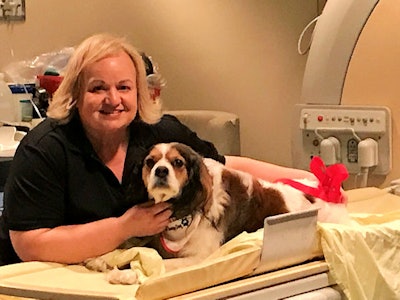
Who doesn't feel better alongside a friendly pup? It's no surprise, then, that pediatric patients who spend time with a therapy dog before and after their MRI scans feel less anxious and more relaxed about their experience, according to a pilot study published April 27 in Pediatric Radiology.
The radiology staff at the Hospital for Sick Children in Toronto has successfully employed two trained canine companions to temper the trepidations of youngsters as they prepare for their imaging exams. The program not only reduces the need for sedation for a majority of patients but does so with no extra scan time and no loss of clinical quality in the final images.
"This is a very effective tool because of the availability of the dogs and the number of children who are benefiting from it," said study co-author Dr. Mary-Louise Greer, staff radiologist and associate professor in the department of medical imaging at the University of Toronto. "It is part of a bigger collection of techniques that all work together and one more thing we can add to minimize the need for sedation of pediatric patients."
Attention-getters
Anxiety prior to an MRI exam is natural for any patient, and it's especially so for children. To help alleviate those fears, radiology departments have crafted creative ways to keep kids distracted, such as with superheroes, beach scenes, and mock MRI sessions.
"We have a unique challenge in children where we have to keep them still, which often requires sedation or anesthesia," Greer told AuntMinnie.com. "There also is a longer wait time for an MRI scan for a pediatric patient who needs sedation, compared with a child who can undergo a scan while awake."
 Dr. Mary-Louise Greer, from the Hospital for Sick Children.
Dr. Mary-Louise Greer, from the Hospital for Sick Children.On average, 25% to 30% of pediatric patients at the Hospital for Sick Children need some form of sedation in order to complete an MRI scan. Due to this additional requirement, the wait time for a scan for these patients is approximately seven weeks, compared with only two weeks for nonsedated patients.
To overcome that challenge, Greer and colleagues looked inside their own hospital and its existing animal-assisted therapy program. A review of previous literature extolled the therapeutic virtues of human and animal interaction, so the decision was made to expand the in-house initiative to the MRI suite.
The prospective study included 21 pediatric patients (median age, 8 years; range, 5.1 to 16.5 years) who were referred for MRI between May 2016 and May 2017 and who met the inclusion criteria. Scans were performed on closed-bore 1.5-tesla or 3-tesla scanners (Achieva, Philips Healthcare; GE TwinSpeed and HDxT, GE Healthcare) for indications that ranged from autism, hearing loss, and developmental delay to tuberous sclerosis and psoriatic arthritis.
What do you think?
The patients were asked to fill out a questionnaire before their MRI scans to rate their anxiety levels and expectations for the scan. After completing the form, patients and their parents or guardians met the therapy dog and its handler in the waiting room. Patients also completed a follow-up questionnaire to provide post-MRI feedback.
To assess the diagnostic quality of MR images from the therapy dog's pediatric patients, the researchers created two control groups, each containing 18 age-matched pediatric patients. One set of controls underwent MRI scans with no general anesthesia, while the other group was given general anesthesia.
"Because we are radiologists and not psychologists, we chose to look at the success rate in terms of improved levels of anxiety ... and we wanted to make sure that the image quality and the time to acquire the study were not impacted," Greer said.
The therapy canines come from the St. John Ambulance Therapy Dog Program, where handlers train and determine the suitability of the dogs for the hospital setting. If a dog relieves itself anywhere in the facility, for example, it is predictably and immediately disqualified from the program.
In-house precautions also are taken for both the patient and the canine. The hospital's infectious disease and prevention staff was actively involved in setting up the project in the MRI suite and ensuring the dog had a clean bill of health so as not to transmit any infections or germs to the children.
Conversely, if a patient were to have methicillin-resistant Staphylococcus aureus (MRSA), then "we run the risk of having the dog infected," Greer said. "We don't want the dog to be harmed or to become a means of transmitting [MRSA] to the children. That now is one of our criteria for a child being excluded from the therapy dog program."
Therapy dog time
The pediatric patients spent between 20 and 60 minutes sitting near Lucy, a 10-year-old Labrador Retriever -- petting her, holding her leash, and engaging in light play under the watchful eye of study co-author and Lucy's handler Joanne Somers, who also answered questions and conversed with the family. Time with the therapy dog depended on that day's MRI scan schedule and time availability.
Lucy was always kept on a loose leash and stayed with the child when the IV was inserted, "which was gratifying to see because the kids were busy petting the dog, and the IV became a much less traumatic experience," Greer said. "The dog also would go into the room and jump on the bed to keep the kids distracted and reassure them within the environment."
Lucy was kept out of the scanner room during image acquisition because of noise levels that can top 110 decibels. To minimize any potential harm, the dog was fitted with "mutt muffs," which canines commonly use during light-aircraft flights. Lucy was allowed in the scanner room between sequences to comfort the child during the exam and was "available after the study was completed as a reward to the children," Greer added.
Anxiety relief
The canine companion did very well to calm the kids' fears. Before the scan, all of the children expressed worry or anger. After the exam, 65% of them reversed their emotions to feelings of relaxation and little worry. One of the 21 study patients did not go into the scanner, so that patient's survey data was not available.
| Impact of therapy dog on pediatric patients before and after MRI | ||
| Anxiety level | Before MRI scan | After MRI scan |
| Angry | 4 (20%) | 2 (10%) |
| Worried a lot | 8 (40%) | 2 (10%) |
| Fairly worried | 8 (40%) | 3 (15%) |
| Very slightly worried | 0 (0%) | 2 (10%) |
| Relaxed/not worried | 0 (0%) | 11 (55%) |
In addition, technologists completed 19 MRI scans (90%) within the therapy dog group, compared with all 36 MRI exams in the control groups. Average total scan time for the therapy dog's patients was 63 minutes, compared with an average of 56 minutes and 58 minutes, respectively, for the two control groups. Average on-table scan time for the therapy dog group was 49 minutes, compared with 44 minutes and 46 minutes, respectively, for the controls. None of these comparisons proved statistically significant.
"While we were very confident that there was no prolongation of the exam itself, we looked at reported movement and reviewed the images as well," added Greer, who was one of two radiologists who blindly rated the results. "We were very happy that the image quality was preserved and that the study duration showed no statistically significant increase in time using this [therapy dog] intervention."
While the researchers are quite encouraged by the results, they also noted in the study that the credit "can't be attributed solely to the animal intervention," adding that 18 patients (86%) also used goggles to watch movies or listen to music. That distraction also could have contributed to their comfort levels.
 Christine Paradis, from the St. John Ambulance Therapy Dog Program, is the handler for Dexter, the hospital's second canine companion.
Christine Paradis, from the St. John Ambulance Therapy Dog Program, is the handler for Dexter, the hospital's second canine companion.Since the study's conclusion, 45 pediatric patients have now participated in the MRI therapy dog program. The hospital also added Dexter, a 10-year-old Cavalier King Charles Spaniel and Brittany mix to ease new patients' fears and reduce the waitlist for MRI scans with sedation.
"For me personally, this study and the evidence-based results are important steps because now we can promote [the program] more widely within the hospital," Greer noted. "This is just one piece of the puzzle. It takes a variety of different novel techniques to make [an MRI scan] a better experience for children."


.fFmgij6Hin.png?auto=compress%2Cformat&fit=crop&h=100&q=70&w=100)





.fFmgij6Hin.png?auto=compress%2Cformat&fit=crop&h=167&q=70&w=250)











